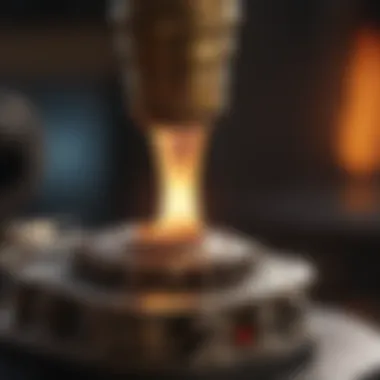Unlocking the Mysteries of Jewelry Torches: An In-Depth Guide for Connoisseurs


Rock and Fossil Identification
When diving into the intricate world of jewelry torches, it is essential to understand the various types available and how each torch can elevate your jewelry-making skills to new heights. From the compact and precise micro torches to the powerful and versatile smith torches, each type offers unique functionalities that cater to specific crafting needs. Additionally, exploring the characteristics of each torch, such as flame temperature, fuel types, and nozzle sizes, is crucial for choosing the right torch for your projects.
Guiding enthusiasts through the maze of torch options, this section breaks down the key characteristics to consider when selecting a torch for jewelry-making purposes. By detailing the differences between torch types and explaining how these nuances impact the crafting process, readers can make informed decisions to enhance their artistry.
Delving further, the subsection on tool maintenance delves into essential tips for caring for your torch and ensuring its longevity. From cleaning procedures to troubleshooting common issues, this section equips enthusiasts with valuable knowledge on keeping their torches in optimal working condition.
Collecting Tips and Techniques
In the realm of jewelry-making, acquiring the right tools and mastering essential techniques are paramount to producing stunning pieces. Whether a novice or an experienced jeweler, this section serves as a comprehensive guide on the best practices for jewelry-making, covering topics such as metal manipulation, stone settings, and intricate designs.
Expanding the horizon of jewelry-making enthusiasts, this section offers expert techniques for creating customized jewelry pieces, from intricate metalwork to setting precious gemstones. By exploring the traditional and contemporary methods employed by master jewelers, readers gain insights into elevating their craft and creating unique, personalized pieces.
Guiding collectors in locating prime materials and understanding the art of extracting specimens safely, this section provides a detailed roadmap for embarking on a successful collecting journey. By uncovering the best practices and tools for collection, enthusiasts can delve deeper into the realm of jewelry-making and elevate their creative endeavors.
Preservation and Display
Upon creating exquisite jewelry pieces, preserving and displaying them is an art form in itself. This section provides insights into various preservation techniques, ensuring that jewelry pieces retain their beauty and integrity over time. From proper storage methods to innovative display ideas, collectors can learn how to showcase their creations effectively and aesthetically.
Through practical tips and creative strategies, this section empowers enthusiasts to preserve and present their jewelry collections in a visually compelling manner. By exploring preservation techniques and storage solutions, readers can prolong the life of their jewelry pieces and curate captivating displays that showcase their craftsmanship.
Geological Insights
Geological insights offer a deeper understanding of the materials and processes involved in jewelry-making. By exploring the geological formations and processes that give rise to precious gemstones and rare minerals, enthusiasts can appreciate the natural beauty that inspires their craft.
This section also delves into the historical significance of gemstones and minerals, shedding light on their cultural and symbolic meanings. Through exploring notable discoveries in the field of gemology and mineralogy, readers can gain a comprehensive understanding of the rich history behind the materials they work with.
Guiding enthusiasts through the intricate world of jewelry-making, this comprehensive guide offers a deep dive into the art, science, and craftsmanship behind creating exquisite pieces. By unraveling the complexities of jewelry torches, collecting techniques, preservation methods, and geological insights, readers can enhance their skills and elevate their passion for jewelry-making.
Introduction to Jewelry Torches
Jewelry torches play a pivotal role in the intricate art of jewelry making. These tools are not merely instruments but essential companions to craft exquisite pieces of wearable art. The significance of jewelry torches lies in their ability to heat metals to precise temperatures for soldering, welding, and manipulating metals into unique designs. Without torches, the delicate and precise work required in jewelry making would be nearly impossible to achieve. In this article, we delve into the world of jewelry torches, offering enthusiasts valuable insights into the different types of torches available, maintenance tips, and advanced techniques to elevate jewelry-making skills.
Understanding the Significance of Jewelry Torches
The Role of Torches in Jewelry Making
When it comes to jewelry making, torches serve as the beating heart of the craft. Their role is multifaceted and indispensable. Torch heat is essential for soldering metal components together, annealing metal for shaping, and welding intricate pieces with precision. The key characteristic of torches in jewelry making is their ability to provide a concentrated and adjustable flame, allowing artisans to control the heat intensity based on the specific requirements of their work. This feature makes torches a popular choice among jewelry makers for their versatility and precision. While torches offer unmatched control and flexibility, they require expertise to wield effectively and safely, making them a valuable yet challenging tool in the jewelry maker's arsenal.


Evolution of Torch Technology in Jewelry Crafting
The evolution of torch technology in jewelry crafting has been monumental, revolutionizing the way artisans work with metals. Modern torches have seen significant advancements in design, efficiency, and safety features. The key characteristic of this evolution is the refinement of fuel delivery systems, flame adjustability, and ergonomic designs aimed at improving user experience and productivity. Jewelers now have access to torches that are not only powerful but also eco-friendly, with precise flame control for intricate work. While the evolution of torch technology has greatly enhanced the capabilities of jewelry makers, it has also raised the bar for craftsmanship standards, pushing artisans to continually adapt and refine their skills to leverage the full potential of these advanced tools.
Overview of Different Types of Jewelry Torches
Butane Torches
Butane torches are popular choices among jewelry makers for their portability and ease of use. The key characteristic of butane torches is their compact size and refillable nature, making them ideal for small-scale projects and on-the-go crafting. However, their limitations lie in their lower heat output compared to other torch types, which may hinder the soldering of larger or thicker metal pieces.
Propane Torches
Propane torches are known for their higher heat output, making them suitable for a wide range of jewelry-making tasks, from soldering to annealing. The key characteristic of propane torches is their versatility in handling various metals and project sizes. While propane torches offer greater heat intensity, they may require a stable working environment due to their larger size and fuel consumption.
Acetylene Torches
Acetylene torches are prized for their high heat output, making them ideal for tasks requiring intense heat, such as melting metals and brazing. The key characteristic of acetylene torches is their ability to reach extremely high temperatures quickly, facilitating efficient metalworking processes. However, their combustible nature and specific handling requirements make them suitable for experienced users who prioritize performance over ease of use.
Hybrid Torches
Hybrid torches combine the best features of different fuel sources, offering users a versatile tool for various jewelry-making applications. The key characteristic of hybrid torches is their adaptability, seamlessly transitioning between fuel types to meet the specific needs of each project. While hybrid torches provide the benefits of multiple torch types, they may require additional maintenance and care due to their intricate design and dual fuel compatibility.
Choosing the Right Jewelry Torch
Factors to Consider When Selecting a Torch
Heat Output and Flame Size
When it comes to selecting a jewelry torch, one of the key factors to consider is the heat output and flame size. The heat output determines the temperature the torch can reach and how quickly it can melt metals for soldering or welding. A torch with adjustable heat settings provides versatility for working with different metals and intricate jewelry designs. The flame size plays a crucial role in controlling the precision and area of heating, allowing for detailed work without overheating surrounding areas. Understanding the dynamics of heat output and flame size helps artisans achieve precise and efficient results in their jewelry-making endeavors.
Fuel Type and Refill Options
Another critical aspect to consider when choosing a jewelry torch is the fuel type and refill options. Different torches use various fuels such as butane, propane, acetylene, or even a hybrid of fuels. Each fuel type has its advantages and considerations, such as burn time, cost, and flame temperature. Similarly, refill options ensure continuous usage without interruptions, making it convenient for jewelry makers to focus on their creative process rather than worrying about refueling. Selecting the right fuel type and refill options aligns with the specific requirements of the jewelry-making techniques and the artisan's preferences.
Ease of Use and Portability
The ease of use and portability of a jewelry torch are significant factors that influence its usability and convenience. A torch that is user-friendly with clear instructions and ergonomic design enables artisans to operate it efficiently, especially during intricate jewelry-making processes. Portability is essential for artisans who work in different locations or require mobility within their workspace. A compact and lightweight torch facilitates easy handling and storage, enhancing the overall workflow and productivity in jewelry creation.
Safety Features


Ensuring safety while using a jewelry torch is paramount in the crafting industry. The presence of safety features such as automatic shut-off mechanisms, flame control knobs, and protective heat shields minimizes the risk of accidents and injuries during torch operation. Artisans must prioritize safety features when selecting a torch to safeguard themselves and their workspace from potential hazards. Investing in a torch with robust safety mechanisms not only promotes a secure working environment but also enhances the longevity and reliability of the equipment.
Comparing Torch Brands and Models
Popular Brands in the Jewelry Torch Market
Exploring the landscape of jewelry torches reveals a diverse array of popular brands known for their quality and performance. Each brand in the jewelry torch market has its unique reputation, whether for exceptional durability, precise flame control, or innovative features. By comparing popular brands, artisans can identify a torch that aligns with their specific requirements and craftsmanship standards. Understanding the strengths and specialties of different brands empowers artisans to make informed decisions when investing in a jewelry torch for their creative pursuits.
Top-Rated Torch Models for Different Applications
Beyond brand preferences, selecting a top-rated torch model tailored to specific jewelry-making applications elevates the precision and artistry in crafting. Different torch models cater to varying techniques such as soldering, welding, annealing, or texturing, offering specialized features for optimal performance. By exploring top-rated torch models for different applications, artisans can discover the ideal tool that enhances their craftsmanship, boosts efficiency, and opens up new possibilities in jewelry design. Choosing a torch model that resonates with the artisan's artistic vision and technical requirements amplifies the overall jewelry-making experience.
Maintenance and Safety Tips for Jewelry Torches
Maintaining and ensuring safety when working with jewelry torches is paramount for both the longevity of your equipment and your well-being as a user. In this section, we will delve into the specific elements, benefits, and considerations pertaining to maintenance and safety tips for jewelry torches, providing essential insights for enthusiasts and collectors alike.
Proper Care and Cleaning Practices
Cleaning the Torch Tips and Nozzles
When it comes to jewelry torch maintenance, cleaning the torch tips and nozzles stands out as a crucial task. By regularly cleaning these delicate components, you prevent blockages and ensure a consistent flame output essential for intricate jewelry work. The unique feature of this practice lies in its ability to optimize the torch's performance, reducing the risk of malfunctions and enhancing precision during soldering or welding processes.
Checking for Gas Leaks
Ensuring there are no gas leaks in your torch setup is non-negotiable for a safe working environment. Regularly checking for leaks not only prevents potential accidents but also guarantees the efficiency of your torch usage. By highlighting any anomalies and addressing them promptly, you maintain a secure workspace conducive to creativity and productivity.
Storage and Handling Recommendations
Proper storage and handling of jewelry torches play a significant role in their longevity and safety. Storing torches in well-ventilated areas away from flammable materials reduces the risk of accidents. Additionally, handling torches with care, following manufacturer guidelines, enhances their lifespan and ensures optimal performance. These recommendations serve to safeguard your investment in quality torch equipment.
Ensuring Safe Usage of Jewelry Torches
Understanding Fire Safety Precautions
Fire safety precautions are foundational to working with jewelry torches. Understanding the flammability of various materials, positioning fire extinguishers nearby, and wearing appropriate safety gear are key characteristics of a safety-conscious jeweler. These precautions not only protect you and your workspace but also foster a professional and responsible approach to torch usage.
Proper Ventilation in Workspace
Adequate ventilation in your workspace is vital when using jewelry torches, as it helps disperse fumes and ensures a healthy breathing environment. Implementing proper ventilation systems, such as fans or exhausts, maintains air quality and reduces the risk of inhaling harmful gases. Prioritizing ventilation contributes to a comfortable and safe working atmosphere for prolonged torch use.


Emergency Response Protocols
Establishing clear emergency response protocols is essential for preparedness in unforeseen situations. Knowing how to handle accidents, such as fires or burns, and having emergency contact information readily available can prevent minor incidents from escalating into crises. By outlining actionable steps and conducting periodic drills, you equip yourself with the skills needed to respond effectively to emergencies, fostering a secure and resilient workspace.
Advanced Techniques and Applications
The section on Advanced Techniques and Applications within the comprehensive guide on exploring jewelry torches delves into the intricate practices that elevate the craft of jewelry making. By pushing the boundaries of traditional jewelry making, advanced techniques open up a world of possibilities for enthusiasts looking to broaden their skillset. This section focuses on highlighting innovative approaches and refined methods that allow artisans to create intricate and unique pieces. Emphasizing the importance of mastering these techniques, the Advanced Techniques and Applications segment serves as a gateway to unleashing creativity and precision in jewelry design.
Exploring Soldering and Welding with Jewelry Torches
Overview of Soldering Methods
In the realm of jewelry making, the Overview of Soldering Methods plays a pivotal role in enabling artisans to join metal components with precision and finesse. This technique involves using the torch's heat to melt solder, which then binds the metal pieces together seamlessly. The key characteristic of this method lies in its capability to create strong and durable bonds between various metals, ensuring the longevity and quality of the final piece. The Overview of Soldering Methods stands out as a preferred choice for jewelry crafting due to its versatility in joining intricate parts efficiently. While it offers exceptional control over the soldering process, artisans must be mindful of overheating risks that could affect the metal's integrity.
Precision Welding Techniques
Precision Welding Techniques signify a refined approach to jewelry making, enabling artisans to execute intricate welds with utmost accuracy. This method emphasizes the precise application of heat to fuse metal components together without compromising their structure. The key characteristic of precision welding is its ability to create seamless connections in delicate or detailed pieces, ensuring a flawless finish. Widely favored for its capability to handle complex designs with ease, precision welding is a valuable asset for artisans seeking perfection in their creations. While offering enhanced control and finesse in welding tasks, artisans need to practice caution to avoid overheating and damaging the metal during the precision welding process.
Creative Jewelry Making with Torch Work
Texturing and Annealing Metal
Within the realm of creative jewelry making, texturing and annealing metal present distinctive opportunities for artisans to add depth and character to their pieces. This technique involves manipulating the surface of metals to create captivating textures, enhancing the visual appeal of jewelry. The key characteristic of texturing and annealing lies in its ability to transform plain metals into dynamic and visually engaging components, allowing artisans to unleash their creativity fully. A beneficial choice for adding unique elements to jewelry designs, texturing and annealing showcase versatility in producing one-of-a-kind pieces. Despite its innovative potential, artisans must exercise caution during the annealing process to prevent structural weaknesses in the metal.
Forming Intricate Designs
Forming Intricate Designs stands as a cornerstone in the realm of creative jewelry making, enabling artisans to craft elaborate and ornate pieces with precision. This technique highlights the intricate artistry involved in shaping metals into intricate forms, pushing the boundaries of traditional jewelry design. The key characteristic of forming intricate designs is its capacity to bring complex concepts to life with stunning detail and finesse. A popular choice for artisans seeking to showcase their craftsmanship, forming intricate designs offers a platform for creating captivating and exceptional jewelry pieces. Despite its advantages in producing intricate details, artisans must hone their skills to manage the complexities of forming precise designs effectively.
Conclusion
In the realm of jewelry making, the conclusion serves as the ultimate encapsulation of one's journey into the world of torch work. Throughout this comprehensive guide on jewelry torches, enthusiasts and collectors have unearthed a wealth of knowledge, from understanding the significance of various torch types to honing techniques and safety practices that elevate craftsmanship to new heights. The importance of the conclusion lies in its ability to tie together the myriad aspects discussed and leave readers with a profound sense of accomplishment and empowerment.
By delving deep into the final thoughts on harnessing the power of jewelry torches, individuals are not only equipped with technical skills but also imbued with a sense of creative exploration and innovation. The conclusion acts as a gateway to unleashing one's full potential in jewelry crafting, offering a pathway to continuous growth and mastery.
Final Thoughts on Harnessing the Power of Jewelry Torches
Elevating Your Craft with Torch Techniques
Elevating Your Craft with Torch Techniques denotes a pivotal aspect of jewelry making that propels artisans towards excellence. Through mastering the intricate art of torch work, craftsmen can sculpt metal with precision and artistry, creating bespoke pieces that exude elegance and uniqueness. The key characteristic of Elevating Your Craft with Torch Techniques lies in its transformative effect on traditional jewelry fabrication methods, adding a touch of sophistication and complexity to designs.
This technique is a popular choice in the jewelry community due to its ability to infuse creations with depth and character, making each piece a masterpiece in its own right. The unique feature of Elevating Your Craft with Torch Techniques is its versatility, allowing artisans to experiment with textures, shapes, and forms not achievable through traditional methods. While it demands practice and skill, the advantages of this technique in jewelry making are unparalleled, offering craftsmen the opportunity to push boundaries and unleash their creative genius.
Continuous Learning and Experimentation
Continuous Learning and Experimentation serve as the lifeblood of innovation and growth in the realm of jewelry making. By embracing a mindset of curiosity and exploration, artisans can push past boundaries and discover new horizons in their craft. The key characteristic of Continuous Learning and Experimentation lies in its dynamic nature, where each new technique or approach contributes to a deeper understanding of jewelry torch work.
This practice is a beneficial choice for individuals seeking to expand their repertoire and challenge their creative boundaries. The unique feature of Continuous Learning and Experimentation is its ability to foster resilience and adaptability in craftsmen, encouraging them to evolve with the ever-changing landscape of jewelry design. While it may entail failures and setbacks, the advantages of continuous learning and experimentation in jewelry making far outweigh the challenges, offering artisans a path to self-discovery and innovation.







